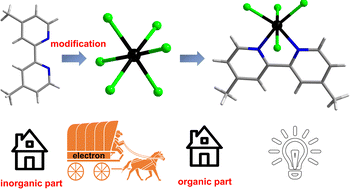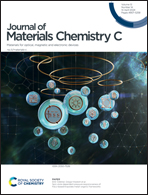A ligand-incorporating strategy towards single-component white light in ionic zero-dimensional indium chlorides†
Abstract
Single-component white-light materials have received much attention due to the rise of white light emitting diodes (WLEDs). Inorganic–organic hybrid metal halides (IOMHs) are considered excellent candidates for single-component white-light materials due to their rich structural tunability and excellent photoluminescence properties. Here, we put forward a strategy to realize effective single-component white-light emission, that is, incorporating a bipyididyl-type emissive ligand into the anionic halometallic unit of an ionic zero-dimensional (0-D) IOMH. As demonstated by the construction of a 0-D In(III)-based IOMH, namely [Ammim][InCl4(dmbp)] (Ammim = 1-allyl-2,3-dimethylimidazolium, dmbp = 4,4′-dimethyl-2,2′-bipyridyl), after partially replacing the chlorine atoms in the chloroindate unit with a dmbp ligand, the resultant compound exhibits broadband white light emission under UV excitation with a photoluminescence quantum yield (PLQY) of 16.70% and a color rendering index (CRI) of 93.2. Systematic studies demonstrate that the source of white light is the charge transfer from the inorganic part to the bipyididyl-type ligand. Our work provides a new path for designing single-component white-light materials with superior photophysical properties.



 Please wait while we load your content...
Please wait while we load your content...